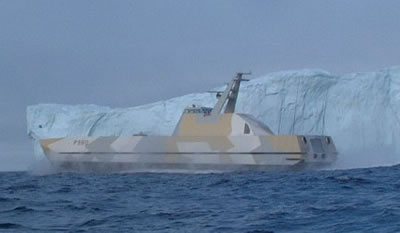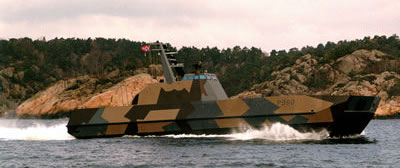The Norwegian Navy has an operational requirement for operations over a long coastal line, in the Economic Exclusion Zone (EEZ) and in support of international operations. The Navy requires to operate a large number of vessels, equipped with relatively large weapons load. One of the systems that will take the challenge is the new 270 tons Skjold Surface Effect Ship (SES). In November 2003 the Norwegian Navy ordered five Skjold class boats to join the first boat, in service since 1999, which is currently undergoing reconstruction.
The Skjold class boat utilizes an an advanced GRP (glass reinforced composites) construction, designed as an air cushion-integrated catamaran design, that offers excellent cruising speed, high transit speed, and high agility in open sea and shallow-water operability. The deck area, parts of the bulkheads, superstructure and hull areas are constructed of hard composite foam (Polymethacrylimide or PMI), which serves as structural sandwich for demanding structures offering superior strength-to-weight ratio and high resistance to temperature. The weight savings achieved by utilizing the foam is approximately 2000 kg.
The stealth design uses extensive Radar Absorbing Materials (RAM) construction in the load carrying structures. Specific attention has also been made to develop special doors and hatches for reduced radar cross section. Other signature reduction techniques are applied to reduce thermal and magnetic signatures. The missiles are integrated inside the GRP hull, to further reduce signature and streamline the external envelope.
The first Skjold prototype built in 1997 is powered by two main engines – Rolls Royce Allison 571 KF 6000kW (2×8160 Hp) gas turbines driving two kaMeWa 80SII waterjets. The cushion is pressurized by lift fans, powered by two MTU 12V TE92 735 kW engines. The combined propulsion offers the boat to accelerate and maintain top speed above 47 knots, at sea state 3, and 55 knots in calm water. The boat can also travel at 8 knots by diesel power. In January 2004 Pratt & Whitney Marine Systems, Inc., was contracted by the Norwegian shipyard Umoe Mandal, to supply gas turbine propulsion for COGAG configuration (combined gas turbine and gas turbine) systems for the six Skjold boats (five new, one reconstructed). Each gas turbine propulsion system will feature two ST18M marine gas turbines and two ST40M marine gas turbines. The ST18M and ST40M are free turbine turboshaft engines derived from Pratt & Whitney Canada’s PW100 and PW150A aviation turboprop powerplants respectively.
Skjold will be equipped with Kongsberg surface missiles, currently under development, and an Oto Melara 76mm super rapid gun mount or an 57 mm or 76 mm gun will be installed on the fore deck. and integrates eight Mistral anti-aircraft missiles, for self defense. The first Skjold class fast patrol boat prototype became operational in 1999, as part of the Norwegian Navy modernization of its Missile and Torpedo boat units. Five more boats was are on order.
The Skjold design provides a basis for the proposed US Navy future Littoral Combat Ship (LCS), proposed by the Raytheon-led Team LCS.

Specifications:
-
Length 47 m
-
Beam 13.5 m
-
Draft 0.9m on cushion, 2.2m off cushion
-
Displacement 270 tons fully loaded
-
Speed at SS3 47 knots
-
Range 800 nautical miles
-
Crew 15 – 18
-
CODOG Propulsion:
2×6,000 kW gas turbines and 2×350 kW diesel -
Armament: 8xSSM Missiles
-
Air Defense: SAM
-
Guns: 57 / 76mm automatic gun
-
Command and control: SENIT 2000 system


















